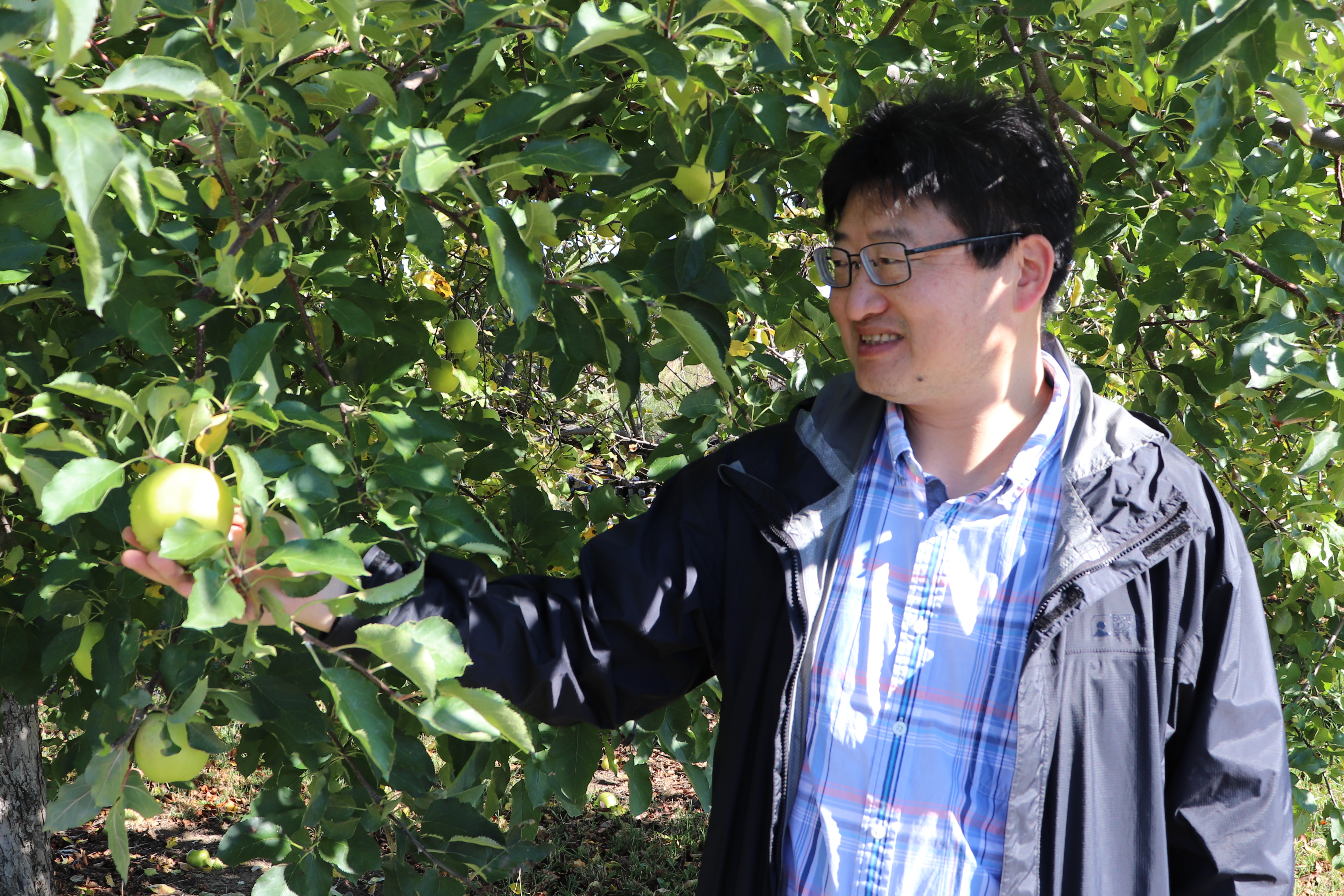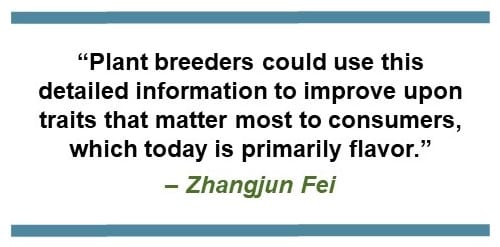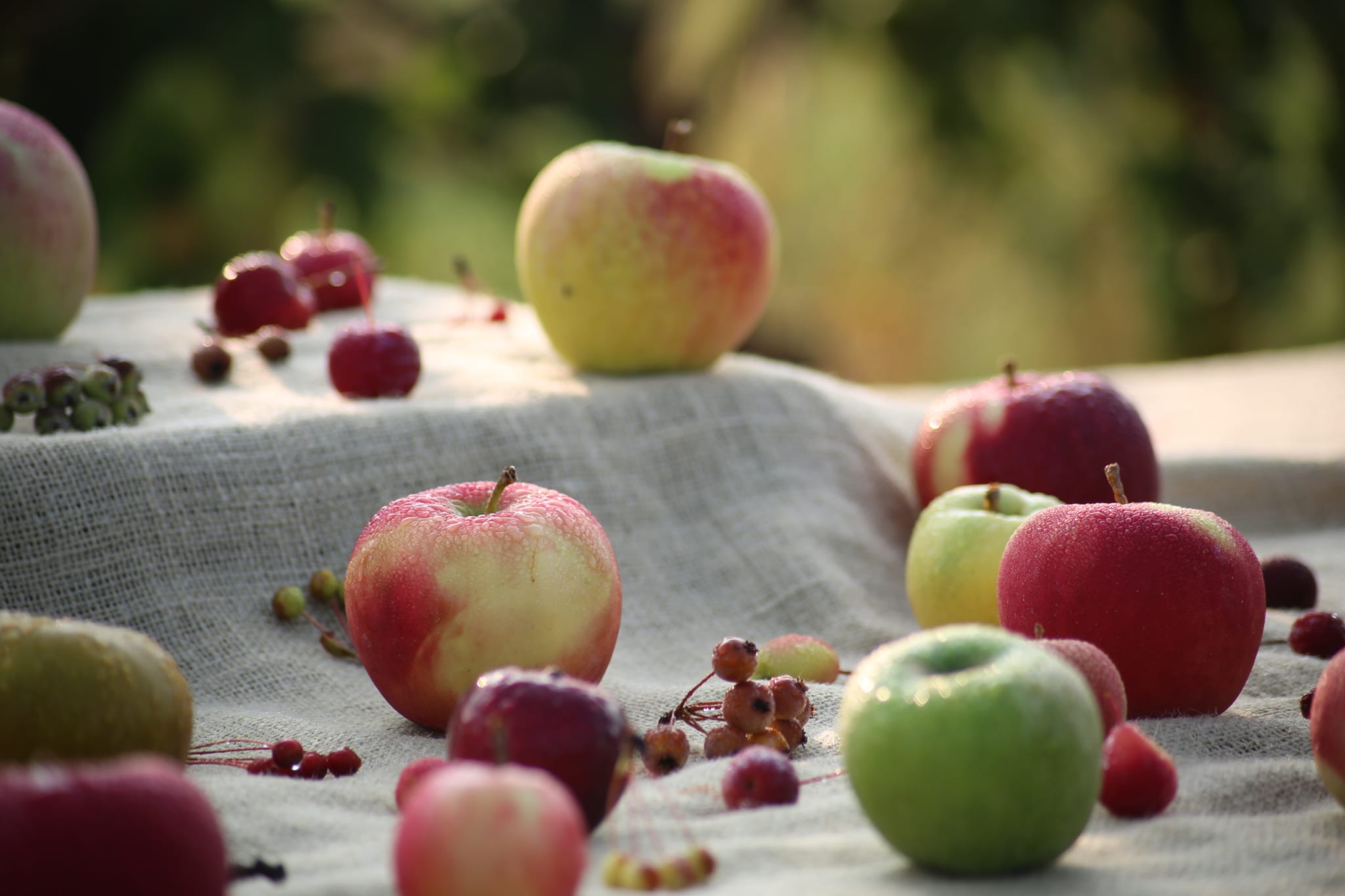News
Silk Road Contains Genomic Resources for Improving Apples

BTI faculty member Zhangjun Fei inspects a Mutsu apple at Indian Creek Farm in Ithaca, NY. Image credit: Boyce Thompson Institute
The fabled Silk Road – the 4,000-mile stretch between China and Western Europe where trade flourished from the second century B.C. to the 14th century A.D. – is responsible for one of our favorite and most valuable fruits: the domesticated apple (Malus domestica).
Snack-packing travelers would pick apples at one spot, eat them and toss their cores many miles away. The seeds grew into trees in their new locations, cross-bred with the wild species, and created more than 7,000 varieties of apples that exist today.
Hybridizations with wild species have made the apple genome very complex and difficult to study. A global team of multi-disciplinary researchers – co-led by Zhangjun Fei, faculty member at Boyce Thompson Institute (BTI), and Gan-Yuan Zhong, scientist with the USDA-Agricultural Research Service (ARS) in Geneva, New York – tackled this problem by applying cutting-edge sequencing technologies and bioinformatics algorithms to assemble complete sets of both chromosomes for the domesticated apple and its two main wild progenitors.
The researchers discovered that the apple’s unique domestication history has led to untapped sources of genes that could be used for crop improvement, such as improving size, flavor, sweetness and texture.
“Plant breeders could use this detailed information to improve upon traits that matter most to consumers, which today is primarily flavor,” says Fei, also an adjunct associate professor in Cornell University’s School of Integrative Plant Science (SIPS).
“Perhaps more importantly,” he added, “the information will help breeders produce apples that are more resistant to stress and disease.”
The research is described in a paper published in Nature Genetics on November 2, with authors from BTI, Cornell University, Cornell AgriTech, the U.S. Department of Agriculture (USDA) and Shandong Academy of Agricultural Sciences.
From the Silk Road to Geneva, N.Y.
 According to Fei, the new study was the outgrowth of an earlier collaboration, published in Nature Communications in 2017, which traced the history of apple domestication and evolution along the Silk Road.
According to Fei, the new study was the outgrowth of an earlier collaboration, published in Nature Communications in 2017, which traced the history of apple domestication and evolution along the Silk Road.
Follow-up discussions among Fei, Zhong and other colleagues at Cornell, inspired them to build better and new apple reference genomes by applying new sequencing and assembly technologies to material in USDA’s Geneva Clonal Repository. The repository, which is housed at Cornell AgriTech, holds the largest collection of apple accessions in the world. Many of these accessions can be traced back to the Silk Road.
In the current work, the researchers sequenced, assembled and compared the full reference genomes for three species: Gala, a top commercial cultivar of M. domestica; and apple’s two main wild progenitors, the European crabapple (M. sylvestris) and the central Asian wild apple (M. sieversii), which together account for about 90% of the domesticated apple’s genome.
The results provide apple breeders with detailed genomic roadmaps that could help them build a better apple.
“We wanted to develop new genomes, especially the wild progenitors, because of the tremendous impact they could have on understanding apple’s genetic diversity and identifying useful traits for breeding new cultivars,” said Zhong, who is also an adjunct associate professor in SIPS.
By comparing the three genomes, the researchers were able to identify which progenitor species contributed the genes responsible for many traits in the domesticated apple.
For example, the team found that the gene giving apple its crunchy texture is located near the gene that makes it susceptible to blue mold.

Examples of different colors, sizes and shapes of apples, a reflection of the diversity of the apple genetic resources or germplasm preserved in ARS Geneva. Image credit: Thomas Chao, USDA-ARS
“Now that we know exactly where those two genome regions are,” Fei said, “breeders could figure out a way to keep the texture gene and breed out or edit out the blue mold gene to produce a more disease-resistant cultivar.”
Discovering what’s missing
The team also assembled pan-genomes for the three species. A pan-genome captures all of the genetic information in a species, unlike a reference genome that captures one individual organism. Pan-genomes are especially important for a very diverse species like apple.
The team identified about 50,000 genes in the pan-genome of the domesticated apple, including about 2,000 that were not present in previously published reference genomes for apple species. “These ‘missing genes’ turn out to be really important, because many of them determine the traits of greatest interest to apple breeders,” Fei said.
Using RNA extracted from different stages of Gala fruits, they also identified genes linked to texture, aroma and other fruit characteristics that were preferentially expressed between the two copies of the genes.
“That provides us and breeders with an even deeper understanding of the genetic diversity underlying a particular trait,” Zhong said.
“The findings will help our group better manage and curate more than 6,000 apple accessions in the USDA Geneva Clonal Repository,” Zhong adds, “as well as enable us to provide critical genetic and genomic information associated with the accessions to breeders and other researchers.”
The team is planning on sequencing other wild apple species, which Fei says may have valuable traits that could improve stress-resistance and resilience in the domesticated apple.
The research was supported by a Non-Assistance Cooperative Agreement between USDA-ARS and BTI (No. 58-8060-5-015), and by grants from the U.S. National Science Foundation (IOS-1855585 and IOS-1339287).


